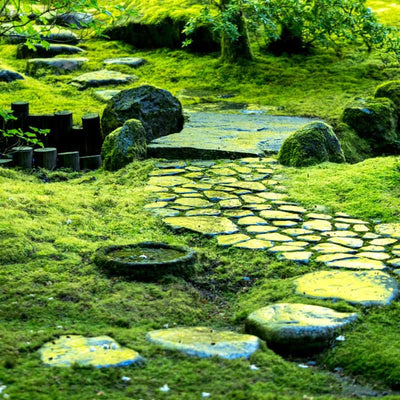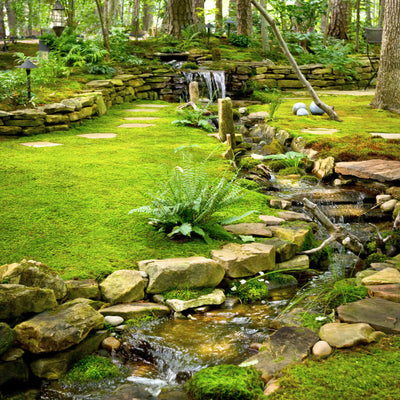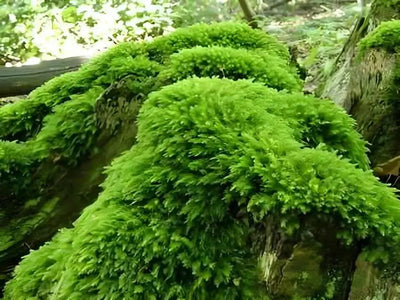Moss is one of the most basic and beautiful groundcovers in nature. The simple moss plant is a beautiful and low maintenance option for gardeners who have damp and shady spots where other plants do not do well. It turns wet spots into soft lush green carpets that give the environment colour and life.
Using moss garden plants not only makes the garden look better but they also help keep the soil moist and stop it from washing away. If you want to hide a dark spot or make a wet path look nice, moss is a natural choice. TN Nursery has many choices, such as Cushion Moss and Sheet Moss, which both do well in damp places and look beautiful on their own.
Best Moss Groundcover Options for Shady Wet Spots
It's important to know that not all types of moss work the same way when choosing moss for moist areas. Some types spread quickly over hard soil, while others do best on rocks or logs. In wet places, these are some of the best moss garden plants:
- Cushion moss: This plant does well in shady places and woodland parks. It loves steady moisture and makes dense, dome shaped clumps.
- Sheet moss: This is great for making a smooth cover that looks like carpet. It's easy to spread, which makes it a great moss for landscaping jobs.
- Fern Moss: This plant has a texture like ferns and looks great growing along shaded paths and in settings that look like forests.
All of these species do best in places with little sunshine but lots of water. Once established, they are low maintenance, moisture loving moss plants.
Moss Absorbs Moisture Well
Mosses are different from other plants because their leaves, not their roots, can take and hold water. Because of this, they are a great choice for fields that stay damp all the time.
Moss for moist areas is a plant that actively enhances soil health. It helps keep the ground below warm and evens out the amount of wetness in the air. This natural process of absorption keeps the dirt from washing away and keeps it moist during dry times.
Remember these straightforward advice if you're learning how to grow moss in wet areas:
- Pick the right spot. Moss grows best in shady places with a lot of moisture in the air.
- Prepare the area by getting rid of weeds and other junk so that the moss can stick to the soil.
- Keep it moist: mist it often for the first few weeks after it's been established.
- Wait. Moss grows slowly at first, but it quickly forms a thick, smooth mat.
How to Choose the Right Moss for Your Damp Landscape
When choosing moss garden plants, you should think about both how they look and how they will do in your garden. Sheet Moss looks great as a decoration on rocks, yard statues and lawns that get some shade. Cushion Moss or Fern moss cover the soil and make colourful ground layers that stay green and fresh.
When picking moss for landscaping, here are some important things to keep in mind:
- Sunshine: Moss likes light shade or sunshine that comes from behind it.
- Wetness: Places with steady humidity or soil that is damp are best.
- Type of Surface: Moss grows well on hardened dirt, wood, or rock.
Picking the right type will ensure long term success, especially in wet or shady spots.
How to Grow Moss in Wet Areas Successfully
It might seem hard to grow moss, but it's actually very easy once you know what it needs. Mosses don't need rich soil or fertilisers because they get the chemicals they need from rainwater.
Here’s a quick young gardener’s guide on how to grow moss in wet areas:
- Get the ground ready by cleaning up the trash.
- Gently press moss pieces into the wet dirt.
- Lightly water to keep it moist until the plant starts to grow.
- Do not use fertilisers on moss because it grows best in places with few nutrients.
Moose are naturally flexible and once rooted they do not need much care which makes them the perfect moss for landscaping for people who want long lasting plants that don't take much work.
The Benefits of Moisture Loving Moss Plants
In addition to making your yard look nice, moss plants that like moisture help keep the environment in balance. This is why they are useful:
- Prevent soil erosion: Keep dirt from washing away because their thick mats hold it down
- Keep water in the soil better: Moss is good at soaking up rainwater
- Increase biodiversity: Moss is a safe place for tiny animals and insects to live
- Easy to take care of: Moss doesn't need to be mowed or trimmed once it's grown
Add Fern Moss to shady spots or between stepping stones for a peaceful forest look as it gives the soil more texture and helps keep it wet even on dry days.
Common Problems and Solutions for Moss Growth
Mosses are tough but sometimes they have trouble if the conditions aren't right. Here are some usual problems and how to solve them:
- Too much sun: Move the moss to a cooler spot or use larger plants to provide some shade
- Bad drainage: Make sure the water moves evenly through the area to avoid pools that don't drain
- Pollution: Chemical fertilisers and herbicides are bad for moss growth, so stay away from them
If you take care of your moss covered yard in these ways, it will grow naturally.
FAQs
Does moss grow in moist areas?
Yes moss does best in places that are damp, dark or humid where other plants might not do well.
What type of moss grows best in moist areas?
Moss types like Cushion Moss, Sheet Moss and Fern Moss do very well in areas with a lot of wetness.
Does moss need soil to grow?
No moss can grow on rocks wood and hardened dirt. It gets its food from the air and rain.
Is moss low maintenance?
Yes once it is established moss doesn't need much care no cutting, trimming or fertilising.
How to remove chemicals from soil before planting moss?
To make sure there is no residue left, rinse the area several times with clean water and let it dry before planting.




